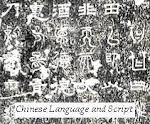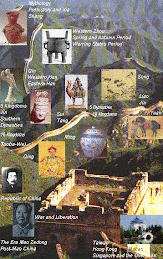 ner Canon, is an ancient Chinese medical text that has been treated as the fundamental doctrinal source for Chinese medicine for more than two millennia and until today. It is comparable in importance to the Hippocratic Corpus in Greek medicine or the works of Galen in Islamic and medieval European medicine. The work is composed of two texts each of eighty-one chapters or treatises in a question-and-answer format between the mythical Huangdi (Yellow Emperor or more correctly Yellow Thearch) and six of his equally legendary ministers.
ner Canon, is an ancient Chinese medical text that has been treated as the fundamental doctrinal source for Chinese medicine for more than two millennia and until today. It is comparable in importance to the Hippocratic Corpus in Greek medicine or the works of Galen in Islamic and medieval European medicine. The work is composed of two texts each of eighty-one chapters or treatises in a question-and-answer format between the mythical Huangdi (Yellow Emperor or more correctly Yellow Thearch) and six of his equally legendary ministers.The first text, the Huangdi Neijing Suwen (素問), also known as Basic Questions, covers the theoretical foundation of Chinese Medicine and its diagnostic methods. The second and generally less referred-to text, the Huangdi Neijing Lingshu (靈樞) [Spiritual Pivot], discusses acupuncture therapy in great detail. Collectively, these two texts are known as the Neijing or Huangdi Neijing. In practice, however, the title Neijing often refers only to the more influential Suwen. Two other texts also carried the prefix Huangdi neijing in their titles: the Mingtang 明堂 ["Hall of Light"] and the Taisu 太素 ["Grand Basis"], both of which have survived only partially.
The most important ancient book of Chinese medicine as well as a major book of Daoist theory and lifestyle is the Yellow Emperor's Inner Classic (Huangdi Neijing, 黃帝內經). The question-and-answer format predominant in the Huangdi Neijing Suwen links together otherwise disjointed texts and is possibly useful for the (anonymous) authors to avoid attribution and blame. (See pages 8-14 in Unschuld for more on these topics.)
The Neijing departs from the old shamanistic beliefs that disease was caused by demonic influences. Instead the natural effects of diet, lifestyle, emotions, environment, and age are the reason diseases develop. According to the Neijing, the universe is composed of various forces and principles, such as Yin and Yang, Qi and the Five Elements (or phases). These forces can be understood via rational means and man can stay in balance or return to balance and health by understanding the laws of these natural forces. Man is a microcosm that mirrors the larger macrocosm. The principles of yin and yang, the five elements, the environmental factors of wind, damp, hot and cold and so on that are part of the macrocosm equally apply to the human microcosm.
In pages 89-90 of the book Celestial Lancets (first published in 1980), authored by the highly respected scholars Joseph Needham (1900-1995) and Lu Gwei-Djen (1904-1991), it states that the consensus of scholarly opinion is that the Suwen belongs to the second century BCE. They further state that evidence shows that the Suwen is earlier than the first of the pharmaceutical natural histories, the 神農本草經 Shennong Bencao Jing (Divine Husbandman's Classic of the Materia Medica). So suggestive are parallels with third and fourth century BCE literature that doubt arises as to whether the Suwen be better ascribed to the third century BCE, implying that certain portions of the Suwen may be of that date. The dominant role the theories of yin and yang and the five elements play in the physiology and pathology means that these medical theories are not older than about 320 BCE.
The German scholar Unschuld states several twentieth century scholars are of the opinion that the language and ideas of the Neijing Suwen were composed between 400 BCE and 260 CE. Further, versions existing today are a simply the last in a series of compilations and that none of the versions that exist today are identical to the texts of the same name from the Han Dynasty (206 BCE–220 CE) era. (See Unschuld pages 1-3 and Sivin page 68 in cited references below.)
Lü Fu (呂複), a fourteenth-century literary critic, was of the opinion that the Suwen was compiled by several authors over a long period. It contents were then brought together by Confucian scholars in the Han Dynasty era. (See page 1 in Unschuld.)
Scholars of excavated medical texts, Donald Harper, Vivienne Lo and Li Jianmin, agree that the systematic medical theory in the Neijing varies shows significant variance from texts found in the Mawangdui tomb (which was closed in 186 BCE). Because of this, they consider the Neijing to have been compiled after the Mawangdui texts.
According to Unschuld (pages 39 and 62) Wang Bing's version of the Huangdi Neijing Suwen was based on Quan Yuanqi's (early six century) commented version of the Suwen consisting of nine juan (books) and sixty-nine discourses. Wang Bing made corrections, added two "lost" discourses, added seven comprehensive discourses on the five phases and six qi, inserted over 5000 commentaries and reorganized the text into twenty-four juan (books) and eighty-one treatises. (See Unschuld pages 24, 39 and 46.)
In his preface to his version of the Suwen, Wang Bing goes into great detail listing the changes he made. (See Veith, Appendix II and Unschuld pages 41-43.)
Not much is known about Wang Bing's life. He authored several books but is best known for his work on the Suwen. A note in the preface left by the later editors of the Chong Guang Bu Zhu Huangdi Neijing Suwen (version compiled by 1053 editorial committee) which was based on an entry in Tang Ren Wu Zhi (Record on Tang [Dynasty] Personalities) states that he was an official with the rank of tai pu ling and died after a long life of more than eighty years. (See Unschuld, page 40. Also see Veith, Appendix I for a translation of an abstract from the 四庫全書總目提要 Siku Quanshu Zongmu Tiyao about both the Huangdi Suwen and Wang Bing.)
For images of the Chong Guang Bu Zhu Huangdi Neijing Suwen printed in the Ming Dynasty, (1368-1644 CE) see the external links section below.
Significant portions of the above Suwen translation (but with only a fraction of the annotations) are currently available in Huang Di nei jing su wen: Nature, Knowledge, Imagery in an Ancient Chinese Medical Text. (See Unschuld in cited references below.)








 History of Traditional Chinese Medicine-Huangdi Neijing Su Wen
History of Traditional Chinese Medicine-Huangdi Neijing Su Wen












